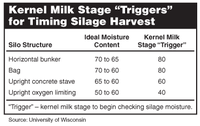Proper Ensiling Requires Accurate Moisture Determination
(Click the image below to view a high-resolution image that can be downloaded)
Corn for silage must be ensiled at the proper moisture to get fermentation for preservation.
“But determining when to harvest corn at the right whole-plant moisture is difficult,” says North Dakota State University Extension Service dairy specialist J.W. Schroeder. “Each storage structure properly ensiles at slightly different moisture optimums.”
Harvesting corn too wet for the storage structure will result in reduced yield, souring and seepage of the silage, and low intake by dairy cows. Harvesting too dry reduces yield; can cause mold to develop; and lowers digestibility, protein and vitamins A and E.
The lateness of this year’s crop has producers guessing. The temperature during September will be crucial to corn and corn silage harvest this year, Schroeder says.
Ideally, the field to be harvested is uniform in development, but the reality is that uniformity rarely is achieved. Separate uneven fields into representative groups if possible. Sample two or more locations for each representative group in the field. Through time, sample the same locations to try to determine the rate of dry down.
Wisconsin corn agronomists report that depending upon the year, the average dry-down rate ranges from 0.4 percent to 0.7 percent per day.
Here are the procedures for measuring plant moisture:
- Sample three to five plants in a row that are well-bordered and representative.
- Put the samples in a plastic bag.
- Keep the sample plants cool.
- Chop the samples as quickly as possible.
- Measure the moisture using near infrared spectroscopy and/or by drying the samples using a Koster oven, microwave or convection oven.
Use 0.5 percent of dry down per day during September to predict the date when a field will be ready for the storage structure. If the weather is warm and dry, use a faster rate of dry down, but if the weather is cool and wet, the rate of dry down is slower.
Another plant indicator that determines the order of fields to harvest is movement of the kernel milk line. Once the kernel milk line begins to move, measure the moisture of fields intended to be harvested for silage.
To better time the initial sampling date, begin when the kernel milk stage reaches the appropriate “trigger” for the storage structure. The corn likely will be too wet, but you will have an indication of how quickly dry down is occurring when the next sampling takes place, Schroeder says.
NDSU Agriculture Communication
| Source: | J.W. Schroeder, (701) 231-7663, jw.schroeder@ndsu.edu |
|---|---|
| Editor: | Ellen Crawford, (701) 231-5391, ellen.crawford@ndsu.edu |


